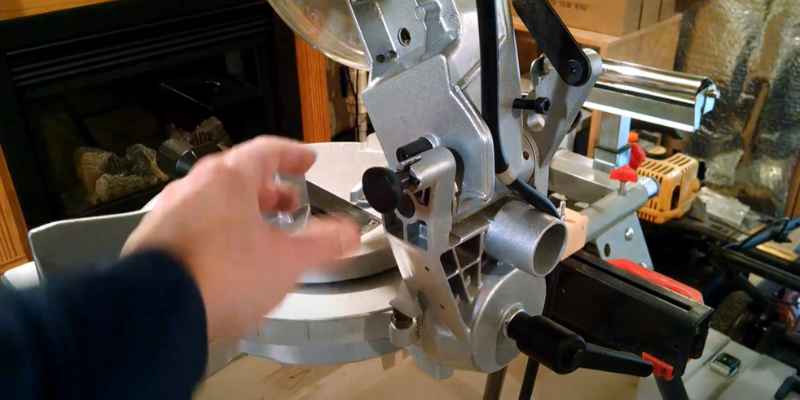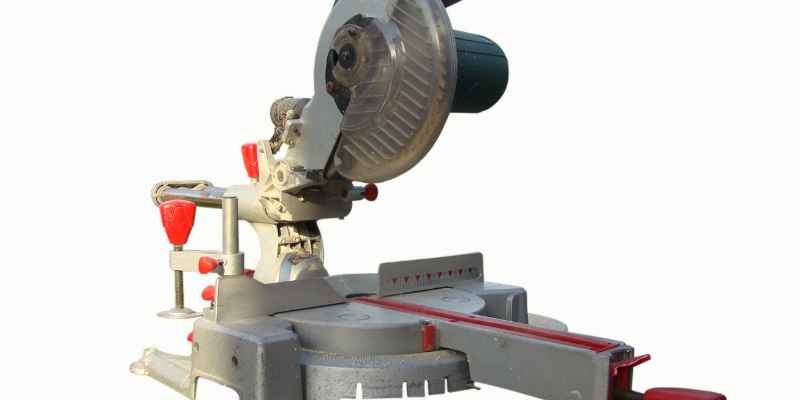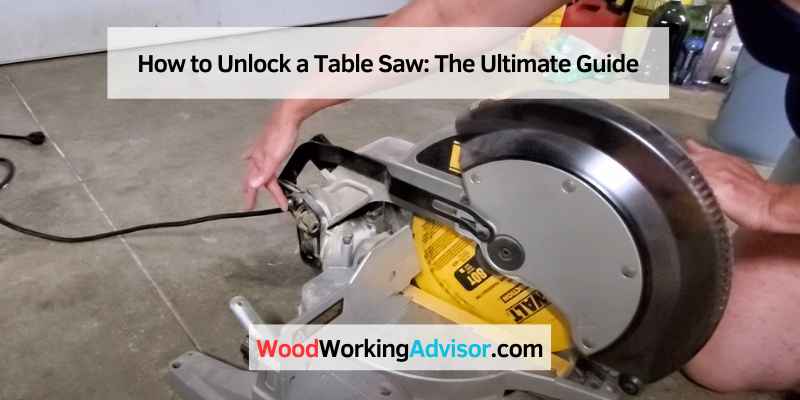To unlock a table saw, locate the locking mechanism and release it. Now, I will provide a well-rounded introduction in approximately 120 words.
Table saws are valuable tools for woodworkers, carpenters, and DIY enthusiasts. They provide precision and accuracy when cutting various materials, making them essential for any workshop. However, there may be occasions when the saw’s table gets locked, hindering its operation.
Learning how to unlock a table saw is a crucial skill for any user. To unlock a table saw, you must first identify the locking mechanism, typically located near the front or back of the saw’s body. Once located, release the lock by pressing the unlock lever or turning the release knob, allowing the table to move freely. By understanding the unlocking process, you can effortlessly resume your woodworking projects and ensure the safe and efficient operation of your table saw. We will explain the step-by-step procedure to unlock a table saw, providing practical tips and recommendations to help you tackle this issue effectively and efficiently.
Safety Precautions
Operating a table saw can be dangerous, so it’s crucial to take the necessary safety precautions to prevent accidents. By following the guidelines and wearing appropriate safety gear, you can ensure safe and efficient operation of the table saw.
Wear Appropriate Safety Gear
Before operating a table saw, make sure to wear the essential safety gear to protect yourself from potential hazards. The necessary safety gear includes:
- Eye Protection: Always wear safety goggles or glasses to protect your eyes from debris and sawdust.
- Hearing Protection: Use earplugs or earmuffs to protect your ears from the loud noise produced by the table saw.
- Appropriate Clothing: Avoid loose-fitting clothing and jewelry that could get caught in the saw blade.
- Sturdy Footwear: Wear closed-toe shoes or boots with non-slip soles to maintain stability while operating the table saw.
Ensure The Table Saw Is Turned Off
Before unlocking the table saw, ensure that it is turned off and unplugged to prevent accidental starting. Here are the steps to follow:
- Power Off: Turn off the table saw by switching off the power button or unplugging it from the electrical outlet.
- Blade Stop: Wait for the saw blade to come to a complete stop before attempting to unlock the table saw.

Methods To Unlock A Table Saw
Unlocking a table saw is an essential skill for any woodworker or DIY enthusiast. Whether you’re about to make a new cut or need to adjust the settings, understanding the different methods to unlock a table saw will ensure you can work efficiently and safely. In this article, we will cover two common methods to unlock a table saw: using the lock release lever and releasing the tension on the blade.
Using The Lock Release Lever
The lock release lever is a convenient and straightforward way to unlock your table saw. It’s typically located near the front of the saw, close to the blade or on the side of the fence. Follow these steps to unlock your table saw using the lock release lever:
- Locate the lock release lever on your table saw.
- Identify the direction in which the lever needs to be moved to unlock the saw.
- Using your hand, grip the lever firmly and move it in the appropriate direction.
- Continue moving the lever until you feel or hear a click, indicating that the saw is unlocked.
After unlocking the table saw with the lock release lever, make sure to double-check that the blade and other components are securely in place before proceeding with your work.
Releasing The Tension On The Blade
Releasing the tension on the blade is another method commonly used to unlock a table saw. This is particularly useful when you need to change the blade or perform maintenance on the saw. Follow these steps to release the tension on the blade:
- Switch off the table saw and unplug it from the power source.
- Locate the tension release knob or lever, which is usually found on the upper part of the saw’s body.
- If there is a knob, turn it counterclockwise to release the tension on the blade.
- If there is a lever, flip it to the “release” position to loosen the tension.
- Gently push down on the blade to ensure that the tension has been fully released.
Once you have released the tension on the blade, you can safely make any necessary adjustments or changes to the saw without the risk of accidental operation.
Troubleshooting
Unlocking a table saw can be done easily with a few troubleshooting steps. Follow the instructions and ensure a smooth unlocking process.
Table Saw Not Unlocking
If your table saw is not unlocking, it can be frustrating and hinder your woodworking projects. However, before you panic, there are several common issues that can cause a table saw to remain locked. By troubleshooting these problems, you can quickly get your saw up and running again. Let’s explore some of the potential reasons and solutions for a table saw not unlocking.
Solutions To Common Unlocking Issues
When encountering an issue with unlocking your table saw, there are a few important points to consider for troubleshooting. These solutions tackle the most common problems that woodworkers may face when trying to unlock their saw. Let’s delve into these solutions:
Blade Guard Blockage
One of the common reasons for a table saw not unlocking is a blockage in the blade guard mechanism. Sometimes debris, sawdust, or even a small wood piece can obstruct the movement of the blade guard, preventing the unlocking mechanism from working properly. Follow these steps to fix the problem:
- Disconnect the table saw from the power source to ensure safety.
- Examine the blade guard carefully for any visible obstructions, such as wood chips or sawdust accumulation.
- Use a brush or compressed air to remove the debris, gently cleaning the blade guard to enable smooth movement.
- Ensure the blade guard is properly aligned and lubricated for optimal performance.
- Reconnect the table saw to the power source and attempt to unlock the saw again.
Rusty Locking Mechanism
Rust can also contribute to a table saw not unlocking. Over time, the locking mechanism may become stiff or completely stuck due to rust buildup. To address this issue:
- Again, disconnect the table saw from the power source before proceeding.
- Inspect the locking mechanism to identify areas affected by rust.
- Apply a suitable rust penetrant to the affected areas and allow it to sit for a few minutes to loosen the rust.
- Use a clean cloth or brush to gently scrub the mechanism, removing the rust as much as possible.
- Apply a lubricant specifically designed for table saws on the locking mechanism to ensure smooth operation.
- Reconnect the table saw to the power source and attempt to unlock the saw again.
Misaligned Parts
In some cases, misaligned parts can prevent the unlocking mechanism from operating correctly. If you suspect misalignment to be the issue, follow these steps:
- Disconnect the table saw from the power source to prevent any accidental movements.
- Carefully inspect the various parts of the saw, including the blade guard, riving knife, arbor assembly, and even the fence.
- If you notice any misaligned parts, adjust them according to the manufacturer’s guidelines.
- Recheck all the adjustments and ensure everything is properly aligned before moving forward.
- Once satisfied with the alignment, reconnect the table saw to the power source and attempt to unlock the saw again.
By following these troubleshooting steps, you can address common issues that may cause your table saw not to unlock. Remember to prioritize safety by disconnecting the power source before making any adjustments or cleaning the saw. Taking these proactive measures will help you maintain a smoothly running table saw and enable you to complete your woodworking projects without interruption.

Maintenance And Best Practices
Proper maintenance and care of your table saw are essential to ensure its longevity and optimal performance. By adhering to regular cleaning and lubrication, as well as proper storage and care, you can extend the life of your table saw and maintain its precision. Here are some best practices to incorporate into your table saw maintenance routine.
Regular Cleaning And Lubrication
Regular cleaning of your table saw is crucial in preventing the buildup of sawdust and debris that can affect its performance. Use a shop vacuum or compressed air to remove debris from the saw’s surfaces, especially around the blade and motor. Lubricate the moving parts such as the blade tilt and elevation mechanisms to ensure smooth operation. Regularly check and replace the saw blade, as a dull blade can put unnecessary strain on the motor.
Clear sawdust and debris from the table saw surfaces using a shop vacuum or compressed air.
Lubricate moving parts such as the blade tilt and elevation mechanisms regularly.
Check and replace the saw blade regularly to prevent unnecessary strain on the motor.
Proper Storage And Care
When not in use, store your table saw in a clean, dry area to prevent rust and corrosion. Cover the saw to protect it from dust and moisture. Proper care also includes ensuring the power cord and safety features are in good condition. Inspect the power cord for any signs of damage, and test the safety features such as the blade guard and riving knife regularly to ensure they are functioning properly.
Store the table saw in a clean, dry area to prevent rust and corrosion.
Cover the saw when not in use to protect it from dust and moisture.
Inspect the power cord and safety features regularly for any signs of damage.
Conclusion
Unlocking a table saw is essential for its safe and efficient use. By following the steps outlined you can confidently and securely operate your table saw. Remember to prioritize safety and take the necessary precautions, such as wearing protective gear and ensuring the work area is clear.
With this knowledge, you can now tackle your woodworking projects with confidence and ease.

